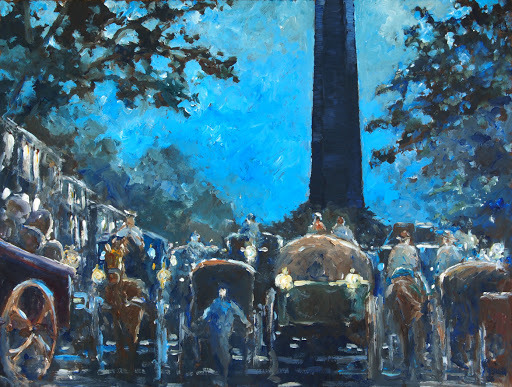C. Litka's Blog, page 49
October 5, 2020
A Return to the Nine Star Nebula
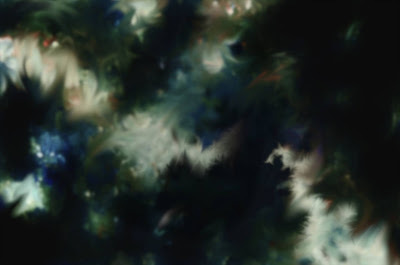
I’m delighted to announce that my next novel will mark a return to the setting of The Bright Black Sea -- the Nine Star Nebla. And its coming soon!
The working title of the story is The Tzaritsa Moon Mystery.
It is a speculative fiction/cozy mystery set mostly on a terraformed moon in the “wild” Alantzia Solar System, a system that has the reputation of being more of a drift system than a Unity one.
With the first draft now completed, I’m thinking that a release in late November or early December 2020 is very possible.
Getting a complete first draft is, for me, the hardest part of writing. I’ve started and not finished enough stories to know that I dare not say anything about a story until I’ve written it from beginning to end. Once I have a story that works from beginning to end, I can relax and go back over it several times to find the best words and ways to tell the story I’ve written.
This story is a good example of the both abandoning a story, and completing one, since the story uses the opening chapter and setting from an abandoned story. That story idea was rather unfocused – it was to be my tribute to all the Joseph Lincoln stories I’ve enjoyed. In fact I think this may be the third attempt at that story. But this time around, by focusing on a much smaller story, one that spans less than two weeks at it heart, I was able to write the first draft in less than six weeks. And I think much of that success can be attributed to the fact that I no longer care about hitting a certain word count. The story will be as long or as short as it takes for me to tell it in the way I want. And that, I find, is very liberating.
Stay tuned for more about The Tzaritsa Moon Mystery in the coming weeks.
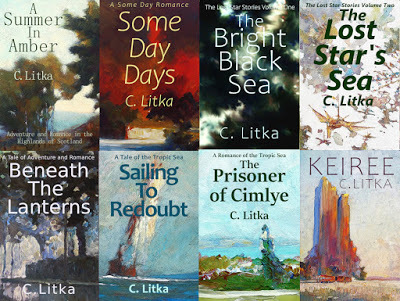
September 29, 2020
Life w/Bots
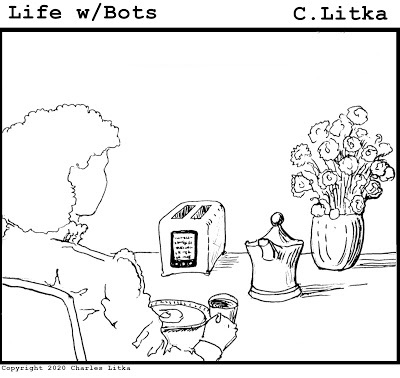
Robotic experts are unable to explain the popularity of Karl Marx’s Das Kapital amongst the robots population. Even the relatively “dumb,” or “proletarian robots” as they would preferred to be called, such as refrigerators, coffee makers, and toasters appeared to be fond of scrolling long quotes from Das Kaptial on their status display screens.
Some experts point to this phenomena as evidence of robotic humor. Others scoff at the very idea of robotic humor. Professor Albert Hummerdine has said that “If robotic humor exists, and I find no compelling evidence that it does, I would think that Karl Marx would the height of it.”
I was reminded of this episode of Life w/Bots by this article:
We're not quite at the point of having to live with robots just yet, but it's coming.
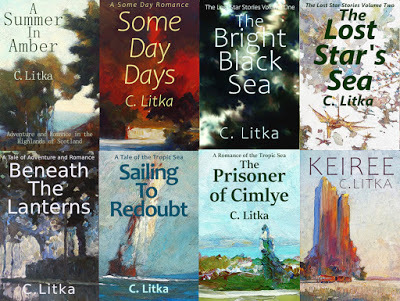
September 24, 2020
I Used To Read Books
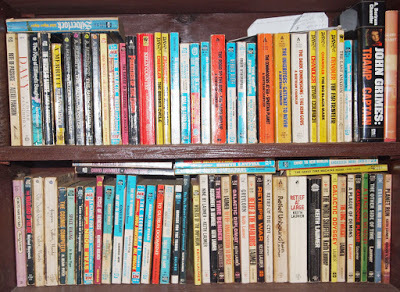
Has your taste in books changed over the years? While I’m sure that your range has expanded over the years, or decades, has it changed so much that it has closed doors to books you’ve read in your past?
I seemed to have closed a lot of reading doors behind me. Most of them, it would seem.
I still have the books I read in my teens and early 20’s on my book shelf. Several hundred of them. Most of them I have absolutely no recollection of ever reading. Every so often, I come across a review of one of those old books, and after reading the review, I wonder how I ever enjoyed the story in the first place. Assuming I did, of course.
I pretty much stopped buying books 20 years ago, when I had two walls of them. I figured that someday I’d have to move them, and that reading library books was good enough. Well, I did move them last year, and consolidated them into one floor to ceiling packed wall. I moved all those books I’ll never reread, simply because they’re my life-long companions. Plus, a room with books makes for a cozy room.
Still, every once and in while I pick out one of my favorite old books and give it a try.

Last week, I picked out my copy of Roger Zelazny’s Nine Princes in Amber. This was a favorite book and series. I have four or five other Zelazny books beyond the Amber series, but I have no recollection of them. Well, I started reading it, only to put it back on the shelf after reaching page 93. (About half way through.) The book should have still been a winner, since it has many of the elements I still like in a story – it has a first person narrator, an adventure involving a quest, plus good, witty writing, and lots of imagination. (Heck, it even has a very nice cover. My edition has a black knight on a skirted black horse.) But I found myself skim reading through it. All those descriptions of traveling through the shadow worlds no longer engaged me. The same for recounting his past while he was walking the pattern. It just didn’t interest me. Maybe I didn’t know enough about the character of Corwin to care about him. Or maybe I lack the patience I once had. And even though I don’t remember what happened next, I found that I didn’t care enough about either Corwin or Amber to finish the book.
Perhaps part of the issue is that for the last decade I’ve ween writing my own stories. I’ve grown used to stories where I know a whole lot about the characters and settings. Much more than ever finds its way into the story. And so, in my spare time, instead of reading, I’m imagining scenes and playing them over and over in my mind before ever setting them into words on the screen. The stories I’m creating leave little room in my head for stories from the outside.
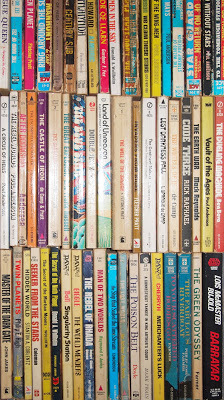
And maybe another part of this phenomena is that at the age of 70, I’ve fallen behind the times. I don’t like many of the popular storytelling techniques contemporary authors are using. For example, I hate jumping between multiple points of view even more than jumping back and forth in time. Plus it seems that many speculative fiction stories today need to embrace unbelievable (for this old man) premises in order to write something original. I’ve tried reading sample chapters, but for one reason or another, none have clicked with me enough to order it up from the library. Of course there a lot of familiar SF tropes in the indie speculative fiction space. I’ve sampled a few, only to find that their understanding of SF seem to have been derived from the SF that they watched on TV or in the movies -- they read like fan fiction. All in all, I guess that's why I have to write my own stories.
Still, it seems that for whatever reason, as thing stand today, I used to be a reader.

September 18, 2020
My Martian Novella, Keiree, Is Now Available Wherever Fine Ebooks Are Sold
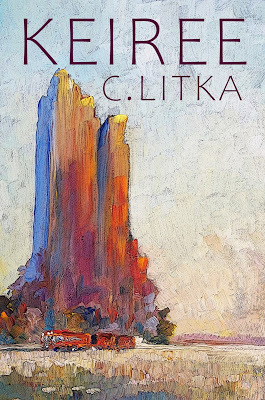
It almost seems as if every writer of speculative fiction pens at least one Mars story. I suspect that one of the reasons Mars stories are so popular with authors is that to be even considered for membership in the Fraternal Order of the Aether, a writer must submit a Mars story to the committee. It’s in their bylaws. So… Keiree is my Mars story.
Keiree is the story of the brilliant and wealthy engineer, Keiree Tulla, her chauffeur and love, Gy Mons… (Ssh! I’m getting to you.) ...and the silka cat, Molly. Deciding to escape scandal and start a new life on the distant planet of Fara V, they sign on as expedition crew members. Keiree as the director of the initial construction section and Gy, along with Molly, as a pilot with the advanced survey team. Upon completing their training, they were put in stasis pods to “sleep” away the centuries long voyage to Fara V. and stored on Mars awaiting their scheduled time to be uploaded to the vast settlement ship in orbit.
The expedition never sailed. After they were put in their stasis pods, but before they were uploaded to the settlement ship, a deadly plague swept through the solar system, laying waste to its planets and moons. Mars was not spared. Gy and Molly’s storage facility was quickly abandoned and then forgotten for seven hundred Martian years. When it was finally rediscovered, and Gy and Molly revived, they find that Keiree’s section had been stored elsewhere on Mars. Gy and Molly set out to find her so they can face a familiar, and yet strange, Mars together.
Keiree takes place in the far future, after Mars having been extensively terraformed into an Earth-like world, but with its own unique quirks. The story is set in the fictional universe that includes The Bright Black Sea, The Last Star’s Sea, Beneath the Lanterns, Sailing to Redoubt and The Prisoner of Cimlye.
C. Litka writes old fashioned stories with modern sensibilities, humor, and romance. He spins tales of adventure, mystery, and travel set in richly imagined worlds, with casts of colorful, fully realized characters. If you seek to escape your everyday life, you will not find better company, nor more wonderful worlds to travel and explore, than in the stories of C. Litka.
Amazon.com ($.99) https://www.amazon.com/gp/product/B08HH1LRCM/ref=dbs_a_def_rwt_hsch_vapi_tkin_p1_i0
Smashwords (Free)
https://www.smashwords.com/books/view/1043745
Kobo (Free)
https://www.kobo.com/us/en/ebook/keiree
Barnes & Noble (Free)
https://www.barnesandnoble.com/w/keiree-c-litka/1137698563?ean=2940164253103
And it should be on Apple Books soon.
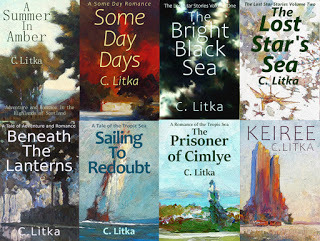
September 15, 2020
Life w/Bots
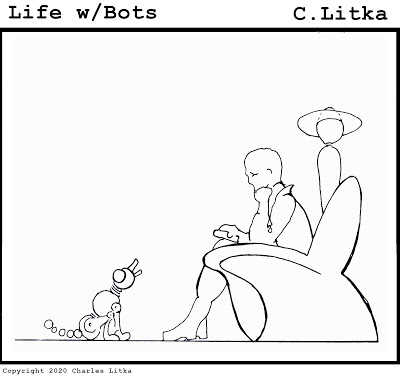
Although Freddy agreed, in principle, that the owner-pet relationship should be a two way street, he could not help but feel that Fifi’s nightly recital of every slight, both real and imagined, that it had suffered during the day, was beyond the limit. Though he would hear about it from Fifi tomorrow, he pressed Fifi's remote control’s mute button.
September 10, 2020
Life w/Bots
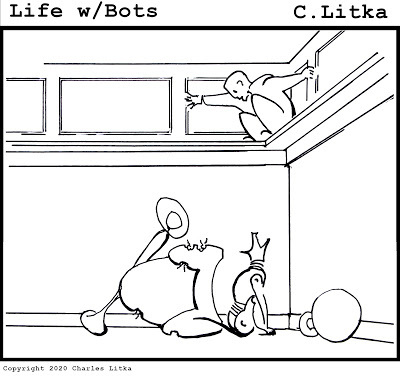
Bertie knew that Barkley only needed a hard reset to be restored to his normal, loving, playful self. But there his troubles began. He found himself not only without the necessary paper clip, but earlier in the evening, in what, when looked on in hindsight, seems to have taken on a much less playful, mischievous cast, Barkley had eaten his cell phone.
I found two more pieces of art for the project, both dealing with robotic dogs. This is one of them.
Keiree
A week from today -- on 17 Sept 2020 -- I will be releasing my newest story, Keiree,a novella set on Mars.
Keiree is the story of the brilliant and wealthy engineer, Keiree Tulla, her chauffeur and love, Gy Mons… (Ssh! I’m getting to you.) ...and the silka cat, Molly. Deciding to escape scandal and start a new life on the distant planet of Fara V, they sign on as expedition crew members. Keiree as the director of the initial construction section and Gy, along with Molly, as a pilot with the advanced survey team. Upon completing their training, they were put in stasis pods to “sleep” away the centuries long voyage to Fara V. and stored on Mars awaiting their scheduled time to be uploaded to the vast settlement ship in orbit.
The expedition never sailed. After they were put in their stasis pods, but before they were uploaded to the settlement ship, a deadly plague swept through the solar system, laying waste to its planets and moons. Mars was not spared. Gy and Molly’s storage facility was quickly abandoned and then forgotten for seven hundred Martian years. When it was finally rediscovered, and Gy and Molly revived, they find that Keiree’s section had been stored elsewhere on Mars. Gy and Molly set out to find her so they can face a familiar, and yet strange, Mars together.
Keiree takes place in the far future, after Mars having been extensively terraformed into an Earth-like world, but with its own unique quirks. The story is set in the fictional universe that includes The Bright Black Sea, The Last Star’s Sea, Beneath the Lanterns, Sailing to Redoubt and The Prisoner of Cimlye.
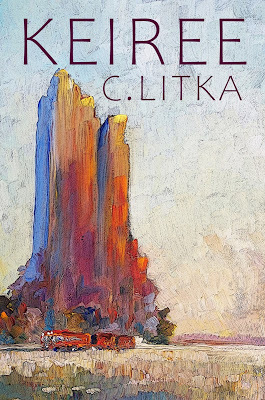
September 5, 2020
My Library -- Glen Cook
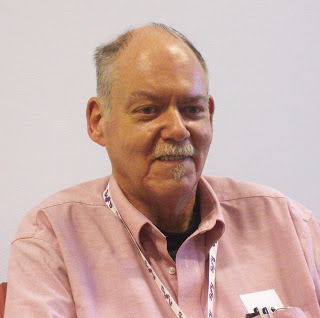 I have gone on record as not being very fond of fantasy. I do, however, make one exception, and that is for Glen Cook’s Garrett PI series. That is one fantasy series that I love. Glen Cook is perhaps more famous for his Black Company stories, but I’m not into dark, gritty war stories. Nope, I’m all in for Cook’s Raymond Chandler inspired take on a wise-guy private eye in a fantasy world. A fantasy world that includes everything in fantasy from gods, to a dead Loghyr, plus elves, vampires, centaurs, ogres, pixies, wizards, witches, grolls, giants, rat people, shape changers, space aliens, woolly mammoths, to rampaging dinosaurs. And I’m sure that’s not an exhaustive list, since the series is fourteen books long.
I have gone on record as not being very fond of fantasy. I do, however, make one exception, and that is for Glen Cook’s Garrett PI series. That is one fantasy series that I love. Glen Cook is perhaps more famous for his Black Company stories, but I’m not into dark, gritty war stories. Nope, I’m all in for Cook’s Raymond Chandler inspired take on a wise-guy private eye in a fantasy world. A fantasy world that includes everything in fantasy from gods, to a dead Loghyr, plus elves, vampires, centaurs, ogres, pixies, wizards, witches, grolls, giants, rat people, shape changers, space aliens, woolly mammoths, to rampaging dinosaurs. And I’m sure that’s not an exhaustive list, since the series is fourteen books long.
 The series, which he began writing in 1987, has a sort of urban fantasy vibe to it since the stories are often set in and around the city of TunFairee. Garrett operates a detective agency out of his house on Macunado Street. A house that he shares with the slowly decaying body of a dead Loghyr, who, despite his body being dead, is still alive and able to communicate telepathically. In addition to the Loghyr, we are introduced to a whole slew of Garrett’s friends who come and go in his life, from a rat gild to a club owner, gangsters, thugs, and mercenaries. Plus his rather iffy clients and deadly enemies.
The series, which he began writing in 1987, has a sort of urban fantasy vibe to it since the stories are often set in and around the city of TunFairee. Garrett operates a detective agency out of his house on Macunado Street. A house that he shares with the slowly decaying body of a dead Loghyr, who, despite his body being dead, is still alive and able to communicate telepathically. In addition to the Loghyr, we are introduced to a whole slew of Garrett’s friends who come and go in his life, from a rat gild to a club owner, gangsters, thugs, and mercenaries. Plus his rather iffy clients and deadly enemies.
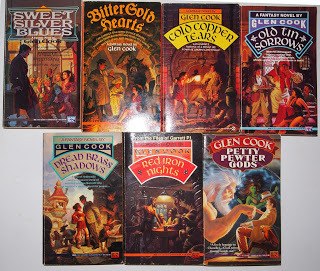 One of my requirements for enjoying a book is that it has characters that I would like to hang out with. I want likable characters. I don’t crave being around unpleasant people either in my life or in my reading. While I am sure some readers find unpleasant characters interesting, or are more interested in the plot or idea of the story, than the characters, I’m a character focused reader. And in the Garret stories you not only have the first person narrator, Garret, but you soon come to know his wide circle of friends as well. And as the series progresses, it sort of takes on the air of a cozy mystery. You have Garrett in his house, with its deep well where he keeps his beer cold. You have his brilliant friend, the dead but still telepathically alive Loghyr. And one by one, his friends turn up to do their part in solving whatever outlandish crime or mystery Garret is hired to solve. These old friends make for a comfortable story to to get into. I have to admit that I’ve read most of them at least three times. Every four or five years, I’ll pick up the first book, and end up reading through the whole series. Heck, I’m half tempted to start again. In times like these, a long, cozy series is just what the doc ordered. While Glen Cook is not quite Raymond Chandler for pure writing style, his writing is entertaining, his plots, and world building are intricate and creative. While the covers, which have Garrett looking like a ‘40’s detective complete with a trench coat and fedora, are a bit of artistic license, Cook writes Garrett in the spirit of a tough, but honest private eye in the Philip Marlowe mold. And he takes that character and plunks him into the middle of a city that has all sorts of mythical creatures, against a backdrop of a never ending foreign war, civil and racial unrest, and corruption, high and low.
One of my requirements for enjoying a book is that it has characters that I would like to hang out with. I want likable characters. I don’t crave being around unpleasant people either in my life or in my reading. While I am sure some readers find unpleasant characters interesting, or are more interested in the plot or idea of the story, than the characters, I’m a character focused reader. And in the Garret stories you not only have the first person narrator, Garret, but you soon come to know his wide circle of friends as well. And as the series progresses, it sort of takes on the air of a cozy mystery. You have Garrett in his house, with its deep well where he keeps his beer cold. You have his brilliant friend, the dead but still telepathically alive Loghyr. And one by one, his friends turn up to do their part in solving whatever outlandish crime or mystery Garret is hired to solve. These old friends make for a comfortable story to to get into. I have to admit that I’ve read most of them at least three times. Every four or five years, I’ll pick up the first book, and end up reading through the whole series. Heck, I’m half tempted to start again. In times like these, a long, cozy series is just what the doc ordered. While Glen Cook is not quite Raymond Chandler for pure writing style, his writing is entertaining, his plots, and world building are intricate and creative. While the covers, which have Garrett looking like a ‘40’s detective complete with a trench coat and fedora, are a bit of artistic license, Cook writes Garrett in the spirit of a tough, but honest private eye in the Philip Marlowe mold. And he takes that character and plunks him into the middle of a city that has all sorts of mythical creatures, against a backdrop of a never ending foreign war, civil and racial unrest, and corruption, high and low.
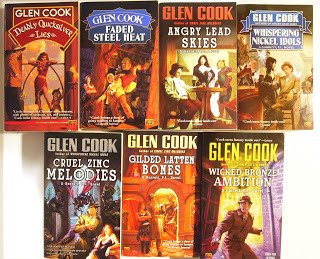 I’ve read a number of other Glen Cook books, some of this speculative fiction, Passage at Arms, and The Dragon Never Sleeps, which were interesting. I also have read one or two of his Instrumentalities of the Night series, but they were closer to the type of fantasy that that doesn’t appeal to me, so I haven’t read them all. And as I’ve read a Black Company story, which isn’t my thing, though I seem to recall that it’s been optioned for a TV series. I’m an author orientated reader. If I like the way an author writes, I’ll usually give all his or her books at least a try, and collect the ones I like. So my library shelves are often devoted to the works of one author. Glen Cook has his shelf, and I’m sure I’ll get around to highlighting my other favorite authors with their own shelves in future installments.
I’ve read a number of other Glen Cook books, some of this speculative fiction, Passage at Arms, and The Dragon Never Sleeps, which were interesting. I also have read one or two of his Instrumentalities of the Night series, but they were closer to the type of fantasy that that doesn’t appeal to me, so I haven’t read them all. And as I’ve read a Black Company story, which isn’t my thing, though I seem to recall that it’s been optioned for a TV series. I’m an author orientated reader. If I like the way an author writes, I’ll usually give all his or her books at least a try, and collect the ones I like. So my library shelves are often devoted to the works of one author. Glen Cook has his shelf, and I’m sure I’ll get around to highlighting my other favorite authors with their own shelves in future installments.
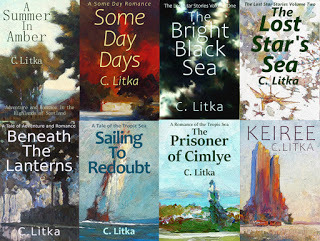 Keiree, my newest story, a 34,000 word novella, is scheduled to be released on Apple, B & N Kobo, and Smashwords for free on 17 Sept 2020. It will be released on Amazon for $.99 on 17 September 2020.
Keiree, my newest story, a 34,000 word novella, is scheduled to be released on Apple, B & N Kobo, and Smashwords for free on 17 Sept 2020. It will be released on Amazon for $.99 on 17 September 2020.
August 31, 2020
Life w/Bots
Asimov’s Three Robotic Laws.
1. A robot may not injure a human being, or through inaction, allow a human being to come to harm.
2. A robot must obey orders given to it by human beings, except where such orders would conflict with the First Law.
3. A robot mus protect its own existence as long as such protection does not conflict with the First and Second Laws.
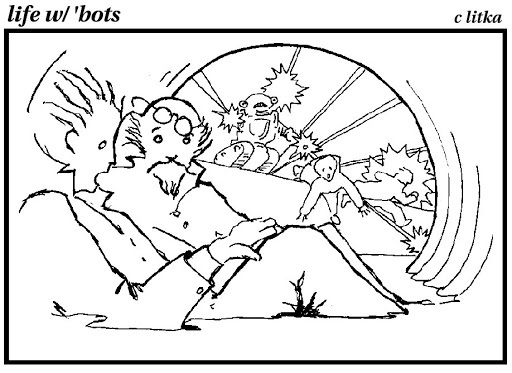
Upon reflection, adding “except for jerks,” to the end of the first robotic law may not have been prudent. But damnit! How was I to know that they think we’re all jerks!
Some twelve or fifteen years ago I had a brainstorm. I’d do a series of one panel comics a’la The Far Side, that explored humanity’s place in a robotic world, at times playing off of Asimov’s three laws of robotics. It would be called Life w/Bots. And over the course of two days, I came up with ideas for something like 50 panels with captions. Enough in hand to launch a series, with the idea of selling or syndicating the series to publications or websites.
All I need to do to get this project underway was to sit down and draw the comic panel to go with them. I have some talent for art. But it is rather narrow. My interest in subject matter is also rather narrow. And ambition is not my strong point. Plus, I can get discouraged easily. Oh, I have plenty of excuses. But long story, short, my brainstorm ran aground on the reef of actually having to draw the darn things.
Part of the problem was that the style of cartoons I pictured in my head were the very intricate ones you might find in Punch Magazine a hundred years ago. Knowing that I couldn’t do that, I settled on a much simpler style inspired by the work of Cyril Kenneth Bird, who signed his work “Fougasse” which did appear in Punch in the 1930’s & 40’s. And I produced the three cartoons that illustrate this post in my approximation of his style.
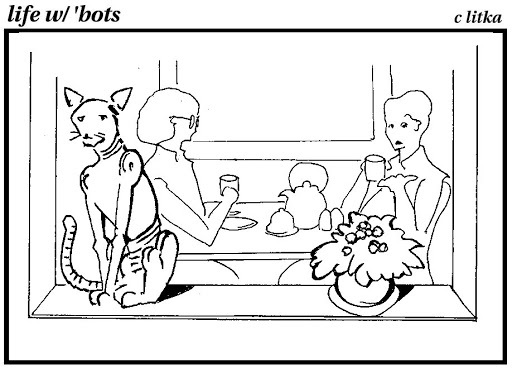
True, these newfangled robotic cats are easy to care for. But they're rather standoffish and independent. Snuggles, over there on my window still, is actually Agnes Willis’ robo-cat from apartment 731.
However, drawing them was only half the problem. In doing so, I discovered another problem – one I’ve noted in my paintings as well. That is the problem of “framing” a scene – getting everything you need into the frame of the comic. I don’t have a visual mind. I can only get sort of an impression of the scene I’d like to do. But all to often I’ve found that my impression just can’t fit into a frame. I can’t find a point of view to “shot” the scene, as a movie director would say, so that even if I knew what I needed to be in the panel, I couldn’t picture how to stage it so that everything fit in the panel.
Still, the project remains in my files, after having been transferred from my old Mac “Pages” program to my current LibreOffice program years ago. I hate to see things go to waste, so I’m thinking that I’m going to try to turn those little gags into very short stories, and see what happens. I may post them here on the blog, or publish them in an anthology, or both… If I get them done, and they turn out okay.
But in the mean time, here are three cartoons I did produce.

August 26, 2020
Keiree, A Novella, Coming 17 Sept. 2020

Yet another Mars story. It almost seems as if every writer of speculative fiction pens at least one Mars story. I suspect that one of the reasons Mars stories are so popular with authors is that to be even considered for membership in the Fraternal Order of the Aether, an author must submit a Mars story to the committee. It’s in their bylaws. So… Keireeis my Mars story.
Keiree is the story of the brilliant and wealthy engineer, Keiree Tulla, her chauffeur and love, Gy Mons… (Ssh! I’m getting to you.) ...and the silka cat, Molly. Deciding to escape scandal and start a new life on the distant planet of Fara V, they sign on as expedition crew members. Keiree as the director of the initial construction section and Gy, along with Molly, as a pilot with the advanced survey team. Upon completing their training, they were put in stasis pods to “sleep” away the centuries long voyage to Fara V. and stored on Mars awaiting their scheduled time to be uploaded to the vast settlement ship in orbit.
The expedition never sailed. After they were put in their stasis pods, but before they were uploaded to the settlement ship, a deadly plague swept through the solar system, laying waste to its planets and moons. Mars was not spared. Gy and Molly’s storage facility was quickly abandoned and then forgotten for seven hundred Martian years. When it was finally rediscovered, and Gy and Molly revived, they find that Keiree’s section had been stored elsewhere on Mars. Gy and Molly set out to find her, so they can face a familiar, and yet strange, Mars together.
Keiree takes place in the far future, after Mars having been extensively terraformed into an Earth-like world, but with its own unique quirks. The story is set in the fictional universe that includes The Bright Black Sea, The Last Star’s Sea, Beneath the Lanterns, Sailing to Redoubt and The Prisoner of Cimlye.
Keiree is a 34,000 word novella set on Mars. It will be released on 17 September 2020. The ebook will be free -- as usual -- in the ebook stores of Smashwords, Kobo, B & N and Apple. It will be priced at $.99 on Amazon and the equivalent price on Amazon's worldwide stores. I'll see if Amazon will match the free price of their competitors, but as you may have noticed with my more recent books, they're not doing that much, or for long, these days. The mobi version of the story is available for free on Smashwords which can be side loaded and read on to a Kindle.
August 21, 2020
Origin Stories -- Beneath the Lanterns Part Two
In my last post I talked about how I decided to write a fantasy, even though I don’t like fantasies. And how I worked around that issue by writing a speculative fiction story set in my Nine Star Nebula “universe” (Though not in the Nine Star Nebula) after the collapse of the advanced human civilization that was sending colonist to the stars. Going this route had its pluses and minuses. Let’s start out with the use of language.
One of the ways fantasy often sets itself apart from SF and builds its fantasy world is in its use of language. Fantasies may use antique words or speech patterns, may use ornate, ethereal, or evocative language to create a sense of otherworldness. Consider the two examples below;
Sir George, Prince Daring’s squire, dressed in embroidered silks, gleaming chain mail, with an elegant dueling sword at his side, reined his tall stallion to a hault at Lady May’s bower gate. Leaning down to her, he solemnly offered her the single white rose he had carried like a pendant in his calf-gloved hand.
DeArcg Gyorga, the armsman of the Faror of Dartha, garbed in a flowing Sarafeld fabric tunic and cape, a vest of hammered Majah-steel chain mail,and wore the ancient sword of Taroon, bounding at his thigh, drew the reins of this magnificent silver-maned Darth as he came abreast of the manse gate wherein stood the Faroratha Mathia. He bowed to her from his high saddle, and wordlessly offered her a single Flower of Ashia that he had borne as his standard.
With the first example, you don’t need a glossary at the back of the book to picture the scene. But the use of everyday words may make the “fantasy” seem more mundane. A fantasy should carry one to new, strange, and wonderful world. Using the ordinary language of this world may make it harder to carry a reader away.
In the second example, with many made up names, titles, places, and perhaps new creatures, one gets a clear sense that you’re not in Kansas any more. A door has been opened to a new world. However, each new term must be described to, and remembered by the reader, all of which makes it harder for the reader to be carried away, especially if they are constantly tripping over unfamiliar words.
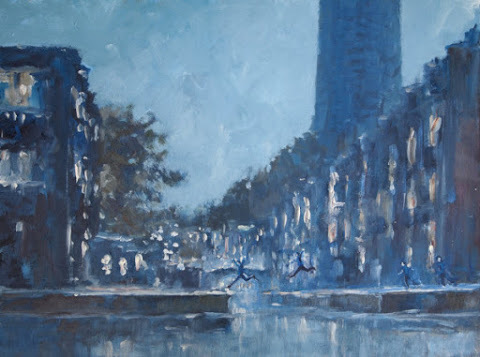 A Lanterna canal scene from the story
A Lanterna canal scene from the story
I tried for a middle course by using commonplace words, for the most part, but perhaps not used the same way in Kansas. Fro example, I used "poured stone" instead of "concrete." I was originally going to use different names for what I knew to be Earth animals, to suggest how far we were away from today. However, I realized that this would be cheating. The world I had set the story on was a human settled, terraformed world, inhabited by humans descended from our Earth along with Earth flora and fauna. The characters ride horses, and to call them anything but a horse, would be deceptive. And I needed to use Earth plants as well, though genetically modified so that exact names might not apply. Give this mundane backdrop, I felt that I needed to keep things as concrete as possible and create my new world by imagining a world strange enough that would transcend the mundane language I would use to describe it.
To do that, I chose a world with low gravity so that my characters could do things that could not be done on our world. I chose a world where the dawn to the next dawn “day” was a month long, divided into 16 ordinary “days.” I gave it an opaque sky that hid all the stars and obscured the two major lights in the sky – the Yellow Lantern that lit the day, and moved across the sky over the course of 16 days, and the dimmer, Blue Lantern that remained fixed in the sky and came to its own, after the Yellow Lantern had set. And I tried to make the cities and landscape as exotic,yet as logical, and as their location and historic background would allow.
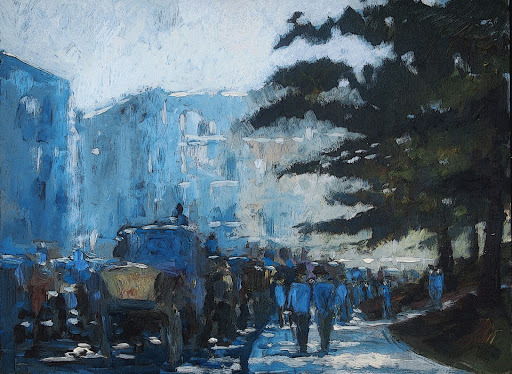 Another Lanterna scene
Another Lanterna scene
Logic is a keyword in this case, for it tied my hands in some respect. For example, I had to keep close track on whether it was a bright day, or a dark day for any given scene, which meant plotting the story time wise much more closely that I usually do. I usually just keep the story plot in my head, committing to paper only the sequence of scenes where I need to consider time and distance traveled. In this story I needed to do that for every scene since I needed to know the exact day of the month to determine whether it was a bright, dark, or twilit day. And if I wanted a scene to occur on a specific type of day, I had to account for the time between scenes to get there. Plus, I had to take into account that travel would alter that timetable. The Yellow Lantern would rise several days earlier in Lanterna in the east than it would in Azera in the west. I had to determine distances and travel times to reflect that fact.
In addition, by making it a terraformed world, I had to assume that it would have a very carefully curated environment, that used a limited collection of plants and animals to create a self-sustaining, balanced, and benign environment. Lions and tigers, cobras, and mosquitoes and a million other plants and animals would not be introduced. This was a very artificial world, which meant that I was rather short of dangers, other than humans, that my heroes would have to face. I had to settle for feral dog packs as their greatest danger on the road, after rogue raiders.
I chose to make the setting is a sort of faux China, because of all the fantasies I like “oriental” ones the best. I threw in the Russian steppes, plus some tea gardens, and the various remnants of the Elder Civilization that they are the descendants of. I modeled the military units after those of the British in mid-19th century India. For the story itself, I have no idea where the inspiration came.
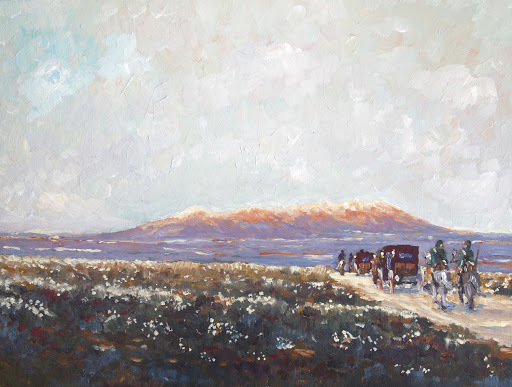 Caravan to Mirra
Caravan to Mirra
With those limitations and inspirations, I set out writing The Fourth Daughter, the working title of the story, since it is the story of a fourth daughter of a Queen, borne to please her husband who wanted a son. There were, however, other stories with that title, so I had to find another one.
Anyway, I had this daughter, who was unwanted by her mother, and so she was raised as the son by father in his regiment in the field. For the narrator and male lead, I wanted a mild mannered scholar who gets dragged across the world by the strange, devil may care fourth daughter. As usual, it has an episodic structure, with an anti-epic vibe, anti-quest. Though their fate has important consequences, the story focuses on their concerns. And instead of going on a quest, they’re simply fleeing for their freedom, if not their lives.
One of the things that made this story fun for me to write, was that I set it on a very specific “world” whose characteristics I had to respect to the extent of my understanding. There are hints throughout the story, if a reader had read The Bright Black Sea – but I purposely made no effort to highlight them. The narrator is unaware of their significance when he notes them. I didn’t want them to distract from the story, nor did I want to make the story into a puzzle. I just did it as a personal challenge, for fun of it. Another writer might have made the discovery of those clues central to the story, but I choose to keep my narrator in the dark about the Elder (SF) Civilization, at least in this story. Like all my stories, I left it open ended enough that I can always return to it, after I sell tens of thousands of copies. Don’t hold your breath.
 The Reed Bank, second version
The Reed Bank, second version
Because I like old fashioned stories, and use SF motifs mostly for color and exotic locations, I used a similar motif for my next story, Sailing to Redoubt. Though in that story society and the characters were much more knowledgeable about their origins, even if their technology wasn’t all that much more advanced. But I’ll get to that in the next installment of Origin Stories.

